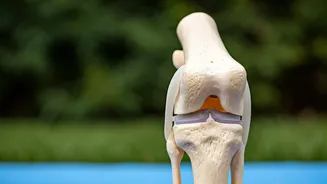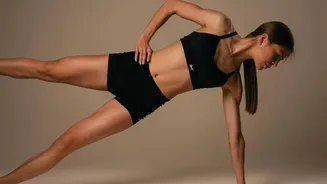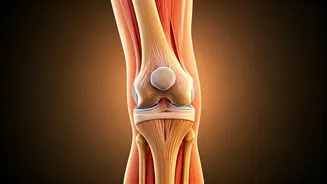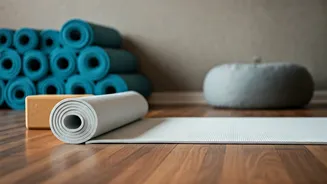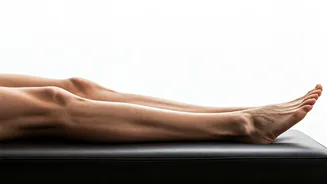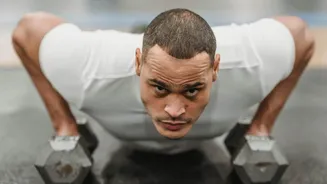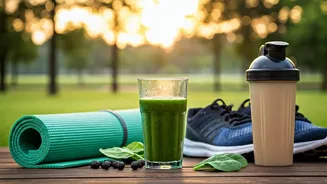Understanding Knee Health
Knee health is crucial for mobility and overall well-being. The knee joint, a complex structure, can be prone to issues due to factors like age, injury,
or overuse. Addressing knee health involves understanding the joint's mechanics and the role of surrounding muscles. Regularly practicing specific exercises and adopting mindful movement can enhance joint function, reduce discomfort, and prevent further problems. Focusing on proper alignment and body awareness during activities helps protect the knees. By being proactive and using simple exercises and lifestyle changes, individuals can safeguard their knee health and maintain an active life.
Tadasana (Mountain Pose)
Tadasana, or the Mountain Pose, serves as a foundational pose in yoga, offering benefits beyond physical posture. When correctly performed, it emphasizes the importance of alignment, particularly in the lower body, thus positively influencing knee health. To achieve Tadasana, stand with your feet grounded, ideally hip-width apart, and evenly distribute your weight. Engage your quadriceps muscles, which support the knees, and slightly lift your kneecaps without locking the joints. Focus on keeping your spine straight and your shoulders relaxed. This posture strengthens the legs and promotes a sense of centeredness, which enhances body awareness. Regular practice of Tadasana helps improve posture and balance, indirectly alleviating strain on the knees and building a strong foundation for more complex asanas.
Vrksasana (Tree Pose)
Vrksasana, or the Tree Pose, is a balance-focused yoga asana that significantly benefits knee health. To begin, stand with your feet together, then gently shift your weight to one leg while bending the other at the knee. Place the sole of the bent foot on the inner thigh of the standing leg, either just above or below the knee, avoiding direct contact with the joint. Ensure your hips are aligned and your core engaged for stability. Reach your arms overhead, palms together, or keep them extended to the sides for balance. This posture strengthens the leg muscles, including the quadriceps, and improves balance, promoting knee stability. The steadying action of the standing leg and the gentle stretch in the hip of the bent leg work together to relieve knee pain and make the joint more flexible. Practicing Vrksasana regularly can enhance coordination and build confidence in your movements.
Trikonasana (Triangle Pose)
Trikonasana, or the Triangle Pose, offers a wonderful stretch and strengthening effect on the legs and core, which translates to healthier knees. Start by standing with your feet wide apart, about 3 to 4 feet. Turn one foot outwards by 90 degrees and the other slightly inwards. Inhale and extend your arms to the sides, parallel to the floor. Exhale and bend at your hip, reaching down towards your front foot with one hand, and extending the other arm upwards. Keep your spine straight and look up towards your raised hand. The pose creates space in the side body and stretches the hamstrings, which influences the alignment of the knees. It improves flexibility and strengthens the legs, contributing to overall joint health. Practicing this pose regularly helps to ease discomfort by releasing tension in the muscles and improving the range of motion in the knees.
Utkatasana (Chair Pose)
Utkatasana, known as the Chair Pose, strengthens the leg muscles while also being gentle on the knees when done properly. Begin by standing with your feet hip-width apart and your arms extended upwards. As you exhale, bend your knees and lower your hips as if sitting in a chair, making sure your knees do not extend past your toes. Keep your back straight, chest lifted, and core engaged. This pose engages the quadriceps, hamstrings, and glutes, which directly support the knees. The act of simulating a sitting position builds strength in the muscles that stabilize the knee joint. It is vital to maintain proper form to avoid overworking the knees. Regularly performing Utkatasana can make the knee joint more resilient and promote better movement patterns. This strengthens the lower body and contributes to improved balance and posture, alleviating strain on the knees.
Setu Bandhasana (Bridge Pose)
Setu Bandhasana, or the Bridge Pose, provides a gentle backbend that can be very beneficial for the knees and overall body alignment. To practice this pose, lie on your back with your knees bent and feet flat on the floor, hip-width apart, close to your buttocks. Place your arms alongside your body. Inhale and lift your hips off the floor, engaging your glutes and core. Keep your thighs parallel and try to lift your chest towards your chin. This pose strengthens the muscles of the lower back, thighs, and glutes, which supports the knees. It promotes spinal flexibility and opens up the chest. The gentle elevation of the hips improves blood circulation, which helps reduce knee pain and inflammation. The strengthening of the back muscles helps maintain better posture, indirectly impacting the knees. Consistent practice can improve joint health by enhancing strength and flexibility in surrounding muscles.
Considerations and Precautions
While yoga is a generally safe practice, it's essential to practice it with awareness and caution, particularly when dealing with knee issues. Before starting any new yoga routine, it's wise to consult a doctor, especially if you have a history of knee injuries or conditions. Pay close attention to your body and never force any pose beyond your comfort level. Modify poses as needed; for instance, if Trikonasana feels challenging, slightly bend the knee of your standing leg to ease strain. Proper alignment is key to preventing further injury, so ensure you have the correct form in each pose. Using props like blocks or blankets can also provide support and make the poses more accessible. Regular practice, coupled with mindful awareness, can help improve your knee health and reduce discomfort. Remember to listen to your body and adjust your practice accordingly.
